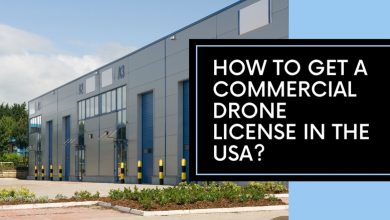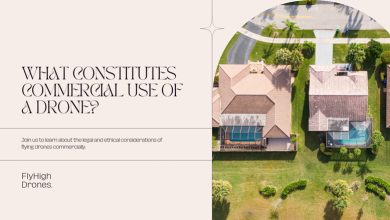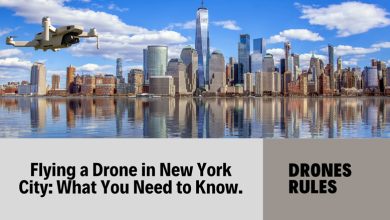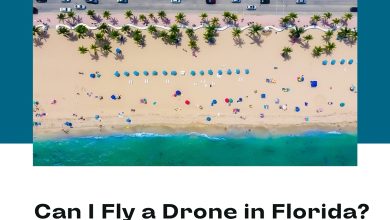How Fast Can a Drone Fly?
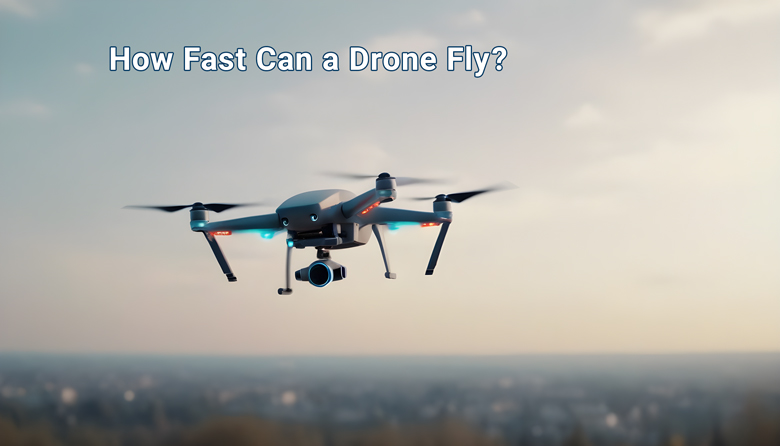
As drone technology takes off, the need to understand their speed capabilities becomes essential. That question, “How fast can a drone fly?” is not so easy to answer!
In this article, we are going to explore the factors influencing drone maximum speeds and compare various drone types.
How Quick Can a Drone Go?
Drones can zip through the sky at various speeds, depending on their type, size, and purpose.
Some consumer drones are cruising at a leisurely 20-40 mph, ideal for capturing scenic shots. However, racing drones, like the cheetahs of the drone world, push the envelope at an adrenaline-pumping 90-100 mph.
When it comes to custom-built FPV drones, some daredevils have clocked speeds exceeding 200 mph, defying gravity and expectations.
What are the factors affecting Drone Speed?
The velocity of a drone is the result of a delicate balance of numerous factors. These factors can definitely affect each drone’s maximum airspeed.
Some of the most important of them are listed below:
1. Drone configuration & design
A drone’s design plays a pivotal role in determining a drone’s flight velocity. Quadcopters, with their four rotors, offer stability but generally have lower speeds compared to fixed-wing drones.
The sleek design of racing drones minimizes air resistance, enabling them to slice through the air at significant speeds.
2. Motor power & RPM
It is fair to say that the heart of a drone lies in its motors. The more powerful the motors, the faster the drone can go. RPM (Revolutions per minute) is a critical parameter here.
Drones equipped with high-RPM motors can generate more thrust, propelling them to greater speeds.
3. Battery capacity & voltage
Batteries not only determine how long a drone can stay airborne but also influence its speed. Higher voltage batteries provide more energy to the motors, leading to increased speed. However, this comes at the expense of reduced flight time.
4. Weight & payload
Like an athlete carrying excess baggage, a heavy drone has to work harder to move. Lighter drones experience less air resistance, translating into faster speeds.
The payload, such as a camera or sensors, can also affect the speed of a drone, particularly during acceleration.
5. Aerodynamics
The shape and aerodynamics of a drone are crucial. Smooth, streamlined designs reduce drag, allowing the drone to cut through the air effortlessly.
Racing drone speeds are a prime example, featuring sleek, low-profile designs that optimize aerodynamics.
6. Environmental conditions
Mother Nature can either boost or hinder a drone’s speed.
Wind plays a significant role, with headwinds slowing a drone down and tailwinds providing a speed boost.
The air density, influenced by temperature and altitude, also influences a drone’s speed performance.
7. Flight mode & Software
Many drones come equipped with multiple flight modes, some of which prioritize speed. Sport mode, for instance, allows drones to reach their top speeds by adjusting flight parameters.
The drone’s flight control software also influences its speed, with some enabling aggressive acceleration.
8. Internal components
The internal components, including the Electronic Speed Controller (ESC) and flight controller, contribute to speed.
A high-quality escort can efficiently regulate motor performance, while an advanced flight controller can fine-tune speed and agility.
How to increase a drone’s speed range?
Enhancing a drone’s speed and range requires a mix of technical knowledge and practical adjustments.
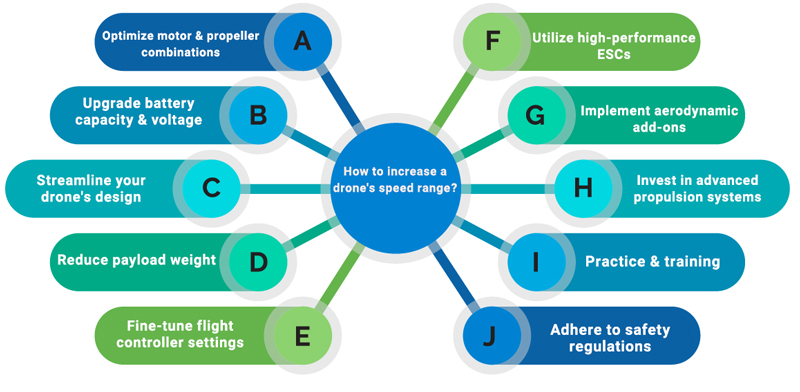
Some of the most practical strategies to increase your drone’s performance and speed are listed below for your review:
- Optimize motor & propeller combinations
Matching the right motor and propeller combination is crucial. Select high-speed motors and lightweight, low-pitch propellers for maximum thrust and speed. Experiment with different combinations to find the sweet spot for your drone.
- Upgrade battery capacity & voltage
To extend your drone’s range and increase speed, consider upgrading to higher-capacity batteries with increased voltage. Be mindful of the added weight, which can impact maneuverability.
- Streamline your drone’s design
Aerodynamics matter. Modify your drone’s design to reduce air resistance. Tuck wires and components neatly, and use streamlined shells and designs for better airflow. Racing drones often feature sleek, low-profile frames for minimal drag.
- Reduce payload weight
Shedding unnecessary payload weight can significantly boost speed and range. Prioritize lightweight cameras and equipment, and only carry what is essential for your mission.
- Fine-tune flight controller settings
Dive into your drone’s flight controller settings. Adjust parameters like pitch, roll, and yaw to optimize agility and speed. Fine-tuning these settings can result in a more responsive and faster drone.
Admin suggestion:
Do I Need a License to Fly a Drone?
- Utilize high-performance ESCs
Electronic Speed Controllers (ESCs) play a pivotal role in regulating the motor of a drone’s performance and speed. Opt for high-quality, high-amperage ESCs to maximize the power delivered to your motors.
- Implement aerodynamic add-ons
Consider adding aerodynamic accessories like airfoils and fins to enhance your drone’s speed range further. These small additions can make a significant difference in reducing drag.
- Invest in advanced propulsion systems
Advanced propulsion systems, such as jet engines or high-performance propellers, can provide a substantial speed boost. Keep in mind that these modifications may require professional expertise.
- Practice & training
Increasing your drone’s speed range also requires honing your piloting skills. Regular practice and training can help you push the limits of your drone safely and effectively.
- Adhere to safety regulations
While enhancing a drone’s speed and range is exciting, always prioritize safety. Ensure you operate your drone within legal and safe parameters and consider potential risks when attempting high-speed flights.
You must keep your drone at least 30 metres away from other people.
You must not fly your drone higher than 120 metres (400 feet) above ground level.
You must not fly over or above people or in a populous area. This could include beaches, parks, events, or sport ovals where there is a game in progress.
What are the fastest drones in the world?
Today, some of the fastest drones in the world can outpace many birds and even challenge the speeds of human-crewed aircraft.
One of the standout names in the world of fast drones is the “XLR V3“. This beast of a drone is known for shattering speed records.
With an average speed of 224 miles per hour and a top speed that touched an overwhelming 257 miles per hour, the XLR V3 has earned its place as one of the fastest drones globally.
Its lightning speed is the stuff of legends and showcases the potential of drone technology.
Another notable mention goes to the “DRL Racer X,” a drone built specifically for the sport of drone racing.
This nimble racer can reach speeds of up to 179.6 miles per hour, making it a formidable competitor in the world of drone racing.
The “DJI FPV” drone is a popular choice for those who crave speed and exhilarating flights.(dji fpv review)
It boasts a top speed of 87.2 miles per hour, providing an adrenaline rush for both beginners and experienced pilots.
When it comes to racing drone speed, the “Nazgul Evoque F5 V2 6S” stands out with an impressive maximum speed of approximately 118 miles per hour.
This drone is perfect for long-range missions and aerial photography when speed is of the essence.
What are the legal speed limits for drones?
Just as with cars on the road, drones also have speed limits, and these limits vary by region and country.
The Federal Aviation Administration (FAA) in the United States, for instance, enforces a maximum speed limit of 100 miles per hour for drones.
You can fly during daylight (30 minutes before official sunrise to 30 minutes after official sunset, local time) or in twilight if your drone has anti-collision lighting. Minimum weather visibility is three miles from your control station. The maximum allowable altitude is 400 feet above the ground, higher if your drone remains within 400 feet of a structure. Maximum speed is 100 mph (87 knots).
This restriction is in place to ensure the safety of both the drone operator and other airspace users.
In the European Union, drone regulations are evolving, and the speed limit of drones can differ between countries.
As of now, in the A1 category, which includes small drones, the maximum permitted speed is around 42 miles per hour (or 19 meters per second).
China imposes a drone speed limit of 62 miles per hour (100 kilometers per hour) in urban areas, which decreases to 31 miles per hour (50 kilometers per hour) in suburban and rural regions.
What are the safety considerations in high-speed drone operations?
High-speed drone operations offer an exhilarating experience, but they also come with a set of unique safety considerations that every pilot must address.
Safety is paramount in drone usage, and flying at high speeds demands extra vigilance.
- Adequate training
Before beginning high-speed flights, pilots should undergo thorough training. This training encompasses not only piloting skills but also an understanding of drone maintenance, performance characteristics, and response to emergencies.
- Pre-flight check
A comprehensive pre-flight check becomes even more critical when aiming for high speeds. Ensure all components are in top condition, from motors and batteries to propellers. Any overlooked issue can become a safety hazard.
- Risk assessment
Evaluate the flight area and identify potential risks. High-speed drones are less forgiving of obstacles or environmental conditions. Plan your flight path to avoid crowded areas, buildings, and other hazards.
- Safety gear
Consider investing in safety gear, such as propeller guards and protective cases, which can mitigate damage in case of a mishap. These add an extra layer of protection for your drone and the surroundings.
- Weather Conditions
High winds, rain, or snow can significantly affect a drone’s high-speed capabilities. Always check weather conditions and be prepared to postpone the flight if conditions are adverse.
- Compliance with regulations
Ensure full compliance with local drone regulations, including speed limits. Ignoring these rules can result in legal consequences and endanger the safety of others.
- Insurance
Consider drone insurance, which can provide coverage in case of accidents, damage, or third-party liability. It offers peace of mind when operating high-speed drones.
User suggestions:
How Are Drones Used in Agriculture?
How to Make Money with Drones 2023?
Can You Fly a Drone Over Private Property?
Can You Bring a Drone on a Cruise?
What are the benefits of high-speed drones?
High-speed drones are not just about adrenaline-pumping excitement; they offer a multitude of benefits that cater to both recreational and professional users.
- Time efficiency
The fastest drones in the world drastically reduce the time required to cover distances or complete tasks. In industries like agriculture or search and rescue, this time efficiency can be critical. Drones can swiftly survey large areas or deliver emergency supplies in record time.
- Aerial photography & videography
For photographers and videographers, high-speed drones open up new creative possibilities. They can capture dramatic shots that were once challenging to achieve. Aerial shots with high-speed drones are a game-changer in filmmaking and content creation.
- Search & rescue
High-speed drones are invaluable tools in search and rescue missions. They can cover expansive areas swiftly, aiding in the search for missing persons or disaster-stricken areas. Their speed can make a difference in saving lives.
- Agriculture
In agriculture, time is of the essence during planting and harvesting seasons. Drones with maximum speed equipped with advanced sensors can monitor crops, detect issues, and take quick action, optimizing agricultural processes.
- Surveying & mapping
The speed of drones is a boon for surveyors and cartographers. They can rapidly collect data, create 3D maps, and survey large areas efficiently. This is particularly useful in construction and land management.
- Racing & entertainment
High-speed drones have spawned an exciting racing and entertainment industry. Drone speed test events attract participants and spectators alike, offering a thrilling spectacle of speed and precision.
- Fast response
In emergencies, such as delivering medical supplies or responding to forest fires, high-speed drones can provide a rapid response. They can transport essential supplies or assess the situation quickly.
- Scientific research
Researchers benefit from high-speed drones for studying wildlife, weather patterns, and environmental changes. The ability to cover vast distances swiftly is a game-changer for scientific expeditions.
- Border security
High-speed drones play a significant role in border security and surveillance. They can quickly respond to potential threats and provide real-time information to security forces.
- Customization
High-speed drones can be customized for various tasks, from cargo delivery to data collection. Their adaptability is a key advantage, making them versatile tools in numerous industries.
Let’s wrap it up
In the world of technology, drones have ushered in a new era of speed and possibility. “How fast can a drone fly?” is no longer just a question but an entrance to innovation!
Whether it is for recreation or pushing the boundaries of industry, the sky is not the limit; it is the starting point.
How do you see the speed of drones shaping our future, and what uncharted territories will they conquer?

